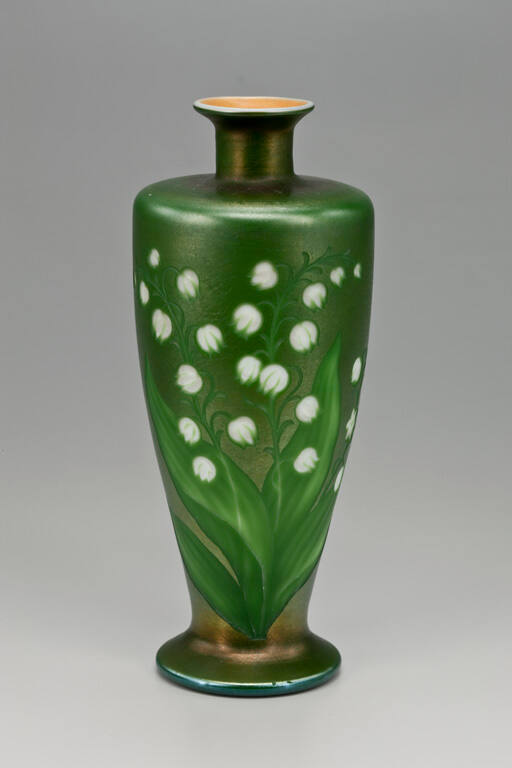
Object Details
Artist
Louis Comfort Tiffany
Date
ca. 1915
Medium
Glass
Dimensions
Height: 8 inches (20.3 cm)
Credit Line
Edythe de Lorenzi CollectionBequest of Otto de Lorenzi
Object
Number
64.0885
BRIEF DESCRIPTIONThis Tiffany vase is made of green iridescent glass. Notice the white lilies of the(…)
BRIEF DESCRIPTIONThis Tiffany vase is made of green iridescent glass. Notice the white lilies of the valley on the surface.WHERE WAS IT MADE?Tiffany glass was made at the Tiffany Glass Furnaces in Corona, located in Queens, New York.WHO WAS THE ARTIST?Louis Comfort Tiffany was the eldest son of Charles L. Tiffany, founder of Tiffany & Company, the New York jeweler. Tiffany was trained as a painter, studying with both George Inness and Samuel Coleman in New York and Leon Bailly in Paris. He eventually turned his attention to decorative arts and began experimenting with glass-making techniques in 1875. After success with stained glass windows and mosaics, Tiffany established the Tiffany Glass Company in 1885 and began devoting production to one-of-a-kind blown glass art objects. He soon became one of America’s most prolific designers, providing furniture, wallcoverings, textiles, jewelry and glass to some of society’s most important citizens.HOW WAS IT MADE?This vase, like most Tiffany vases, was made by blowing the glass on a blowpipe. The shimmering iridescence is a decorative effect achieved by introducing metallic substances into the batch of molten glass or by spraying the surface of the vessel with oxides like stannous chloride or lead chloride and then reheating it in a reduced atmosphere. Ancient glass, much admired by Tiffany, often has an iridescent appearance caused by the effects of weathering.The lilies of the valley are realistically depicted using an intaglio technique. With this technique, a design is cut below the surface of a glass object in order to produce an image in relief. This vase also features metallic gold luster decoration upon the inside of the mouth as well as deep blue-green around the footed-base. Luster is a form of staining; this shiny metallic effect involves covering the surface of a vessel with metallic oxides that have been dissolved in acid and mixed with an oily medium. The vessel is then fired in a kiln at a temperature around 1150 degrees Fahrenheit, depositing a film upon the surface that, when cleaned becomes shiny.WHY DOES IT LOOK LIKE THIS?The spray of natural looking lilies of the valley is typical of Tiffany’s Art Nouveau style objects. Art Nouveau, French for “New Art,” refers to an artistic style that was developed in Europe in the 1880s, and remained enormously popular into the first decade of the 20th century. It is characterized by whiplash curves, organic imagery and sinuous lines. The name Art Nouveau came from the Paris shop of Siegfried Bing that opened in 1895, quickly popularizing the works of artists like Louis Comfort Tiffany, whose work became synonymous with (or symbolic of) the American Art Nouveau style.This vase is an example of Tiffany’s Favrile glass. In 1894, Tiffany patented his iridescent glass under the name Favrile. The word Favrile is derived from the Old English fabrile meaning hand-wrought. Inspired by glass from ancient Rome and the Islamic world, Venice and Bohemia, Tiffany glassmakers copied many of the colors, texture, decoration and unique forms made long ago. Tiffany combined his talent as a colorist, naturalist, and designer with his experimentations on blown glass surfaces. Vessels were fumed with metallic oxides to achieve iridescence.To see other examples of Tiffany’s Favrile glass in the Johnson Museum’s collection, search for object numbers 57.072, 57.080, 57.088, 57.097, 57.106, 64.0840, 64.0841, 64.0842, 64.0843, 64.0850, 64.0865, 64.0875, 64.0879, 64.0889, 64.0898, 64.0904, 99.078.118 a,b, and 2001.075.003 in the keyword search box.












